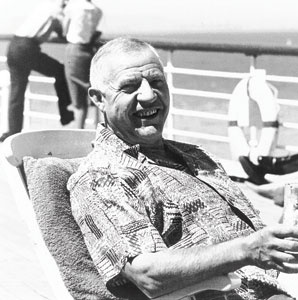 It may be kitschy—even downright tacky—but Trader Vic’s and its tiki flair are here to stay.
It may be kitschy—even downright tacky—but Trader Vic’s and its tiki flair are here to stay.
My parents tasted their first kiwi at Trader Vic’s in San Francisco in the spring of 1962. My mother grew up in Minneapolis, and Vic’s was the most exotic place she’d ever seen. “Everything was sprinkled with coconut and served in a hollowed-out pineapple,” she recalls. “I can’t stand coconut or pineapple, but for whatever reason I loved Trader Vic’s.” It has that effect.
From inauspicious roots—a dive bar in Oakland called Hinky Dink’s—Vic Bergeron spread the tiki craze around the nation like so much sticky-sweet rib sauce. Along the way, he did something even more lasting: he gave Americans the travel bug. Where would our tropical fantasies be without Vic’s hurricane lamps, dugout canoes, and rum punches? This was how a whole generation first experienced the South Pacific, or wherever the hell we were presumed to be. (Vic’s has always been an amalgam of island cultures real and faux, the brick-and-mortar equivalent of Esperanto.) Of course, kvetching about geographical correctness misses the whole point, which is to get thoroughly and unapologetically blotto. Hence the drink menu’s hilarious emphasis on potency: “Persuasive ammunition for toppling giants!” or “No sissy drink, this!”
To be truthful, the cocktails are kind of gross when, God forbid, you taste them sober. It helps that they’re big and colorful, and usually on fire. And strange things happen on the other side of a Scorpion Bowl. People lose a certain sense of decorum. I’ve never seen a werewolf drinking a piña colada at Trader Vic’s, but I’ve seen just about everything else.
Bergeron died in 1984, but the brand that bears his name now includes 30 outposts worldwide, from Tokyo to Bahrain. Long may their Fog Cutters flow.
After visiting the tiki-themed Don the Beachcomber bar (a favorite of Charlie Chaplin), in Los Angeles, Victor “Trader Vic” Bergeron revamps his Oakland sailors’ pub Hinky Dink’s. The new restaurant, Trader Vic’s, which is decked out in carved wooden masks and palms, is soon declared the “best in the Bay Area” by Pulitzer Prize–winning journalist Herb Caen, in the San Francisco Chronicle.
Trader Vic’s introduces the mai tai (Tahitian for “very best”), a rum-based cocktail made with lime, orange curaçao, and sundry sweet syrups. Though when the founder of Don the Beachcomber dies years later, the New York Times obituary mistakenly credits him—not Vic—with the mai tai’s invention.
U.S. soldiers stationed in the South Pacific return home from World War II with tales of white-sand volcanic islands, women in grass skirts, wild dance and drum festivals, and tropical trees dripping with exotic fruits. America’s tiki trend officially takes off.
In a seven-page spread, Life magazine declares Vic Bergeron the “Aristotle of Alcohols” and “the undisputed monarch of South Seas fixings.” A San Francisco outpost opens, beginning the company’s 25-year run of rapid U.S. expansion. Next targets: Beverly Hills (1955) and Chicago (1957).
A three-hour tour turns into a three-season tiki adventure as the seven castaways on Gilligan’s Island try to escape from their desert isle, an uncharted tropical paradise located either 300 or 1,200 miles from Hawaii (depending on the episode).
With “flower power” on the rise and 1950’s values in question, the countercultural movement begins. Along with society staples like starched white shirts and ties, Trader Vic’s and tiki hit hard times.
Yul Brynner sues the New York City Trader Vic’s at the Plaza Hotel for $3 million, claiming food poisoning from undercooked ribs. He wins, and from then on all meat is prepared well done.
Nineteen years later Donald Trump closes the now famed Trader Vic’s downstairs at his (newly acquired) Plaza Hotel, in New York City, declaring that the bar had “gotten tacky.” Coming from The Donald, that means something.
After 10 years as a virtually tiki-free zone, New York City welcomes a wave of tiki-themed bars and restaurants, such as Manhattan’s Waikiki Wally. The New York Times attributes the return of tiki to “the stress brought on by the attacks of Sept. 11, 2001…fear of travel and need for emotional escape.”
Taschen publishes Sven Kirsten’s Book of Tiki, putting tiki back on the map.
United Airlines begins offering Trader Vic’s “award-winning cuisine and world-famous cocktails” in flight, just as it did in 1975. It is one of the first partnerships between an airline and a restaurant.
Trader Vic’s celebrates its 75th anniversary with new restaurant openings around the world, including 11 Caribbean outposts planned for the next five years. Trader Vic’s is back, baby, and it’s sandier than ever. —Catesby Holmes